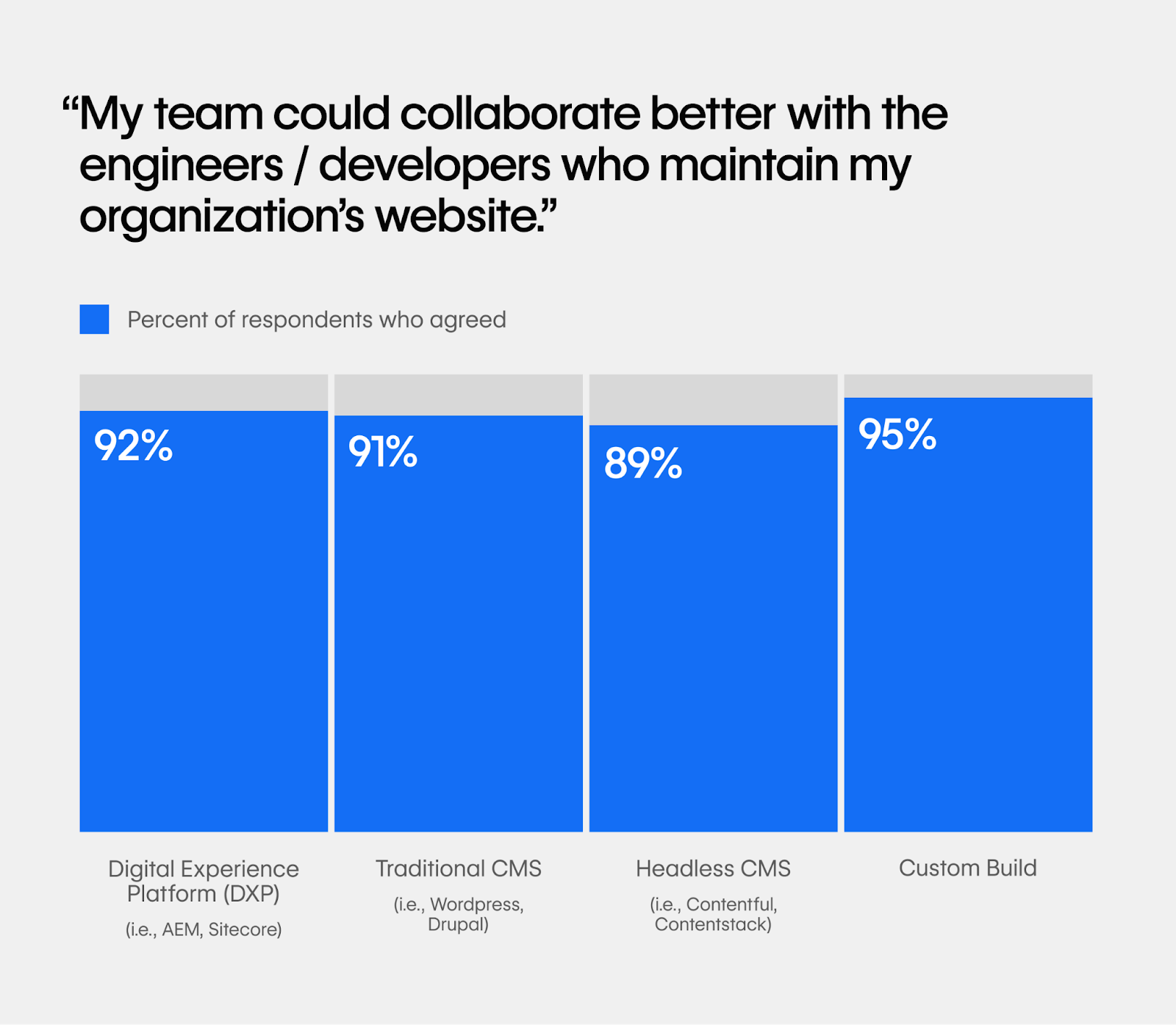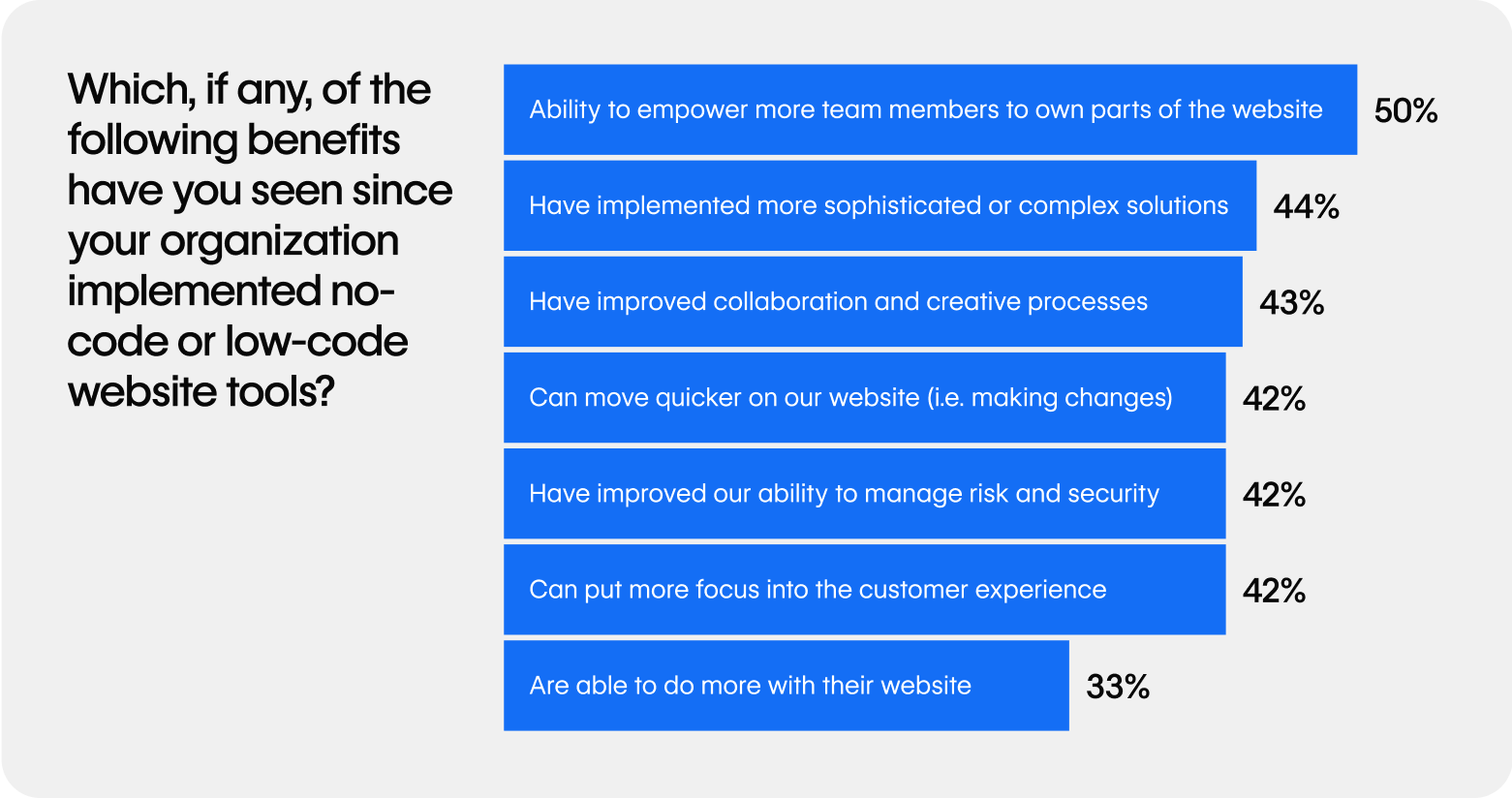A great website can power a successful marketing campaign — but only if you manage to build one.
That’s harder than it sounds. In fact, we surveyed 500 marketing leaders from the US and Canada and found that the majority of organizations struggle to deliver a marketing website they’re satisfied with. And while designing, developing, and launching robust websites is no walk in the park, our data suggests traditional technologies — ones that should be making web development easier — are actually a big part of the problem.
But there is hope: modern web development tools are already helping teams overcome common challenges they face when building new web experiences.
Let’s take a closer look at how.
Good marketing websites are critical but often challenging to get right
Marketing websites play many roles: they build up the brand’s image and credibility, deliver the information that potential users need to start using a product or service, and advertise new product launches. When built effectively, these sites can help companies maintain a steady stream of new interest, even as customers’ expectations shift faster than ever. That’s why 92% of the leaders believe that improving their websites is crucial to reaching their business targets.
And if their spending is any indication, their companies agree: the businesses we surveyed spend an average of $1.6 million per year on teams and software to support their website.
But in spite of this investment, teams still feel like their sites are falling behind. Over half say that their brand doesn’t align with the site, 57% say that it’s harder to meet customer expectations than it was a year ago, and 61% say that they struggle to manage their teams’ workloads.
But why is it so hard to build a powerful marketing website?
The answer? Traditional web development tools.
Current tech stacks are getting in the way of marketing
The software and tools that many of today’s companies use to develop their websites often introduces a lot of headaches that hold teams back. While a growing number of companies are adopting low- or no-code systems, many still rely on DXPs or custom builds. Under these setups, engineers tend to own the process of updating the website. This means that when marketers want to launch a new campaign, they’ll have to write a ticket for an engineer to implement that change, and then wait for the ticket to be addressed by an already swamped engineering team.

Naturally, marketing teams aren’t satisfied with this way of working. Over 60% of survey respondents said that their current web tech stack is missing the mark — with a common pain point being the long lag times involved in updating the website. Roughly a third of respondents reported that it takes at least two weeks to make even simple copy edits, and 54% said that updates to the website are either too time-consuming or difficult to implement. This glacial pace makes it much harder for marketers to react to evolving customer expectations.
Outdated ways of building for the web are stripping marketers of autonomy
Lack of ownership is another pain point shared among marketing leaders at leading enterprises. Traditional web development systems place marketers and developers in separate silos, and subsequently marketers don’t have enough control over the website. 81% of survey respondents shared that their work is restricted by engineers or other teams and 36% said that their teams want to have full ownership over their website, but don’t. It’s also clear that collaborating with these silos in place is a major challenge, one exacerbated by the web tools many of today’s teams are using.

Visual development platforms can unblock marketing teams
Many of today’s organizations are incredibly aware of these web challenges and have already started seeking solutions. A number of companies we surveyed reported they are turning to no- and low-code web solutions. These solutions help non-technical teams make changes to their websites — which 50% of respondents shared is difficult to do with their current web infrastructure — without having to go through an engineer.
Switching to more modern web development tools allows marketing teams to own more of the web development process. We’ve seen this shift come to life firsthand at companies like Dropbox Sign, who were able to reduce the number of web development tickets assigned to engineers by 67% after switching to Webflow.
Adopting these solutions also had clear benefits to teams’ well-being: teams feel more in control of their workflows and their team’s bandwidth, are able to make website updates more swiftly, feel less restricted by their former web development processes, and are simply able to do more with their website than ever before.

Having the right web tech stack matters
It’s clear that having the right web tech stack in place can be the difference that propels companies ahead of the competition and puts them in lockstep with their marketing goals.
With the right solutions on your side, websites can be reliable, scalable, and easy to update — freeing up precious time so your teams can focus on impactful marketing campaigns and product strategies that drive the business forward.
Curious to learn more about how modern web development tools can positively impact your marketing strategy ? Read our entire research report, The 2024 State of the Website, to dig into more data and glean recommendations for building the most powerful website possible in the new year.



















The 2024 State of the Website
Discover key challenges today's marketing teams are facing, as well as opportunities for businesses in 2024.
































